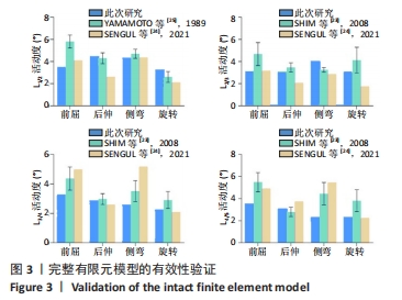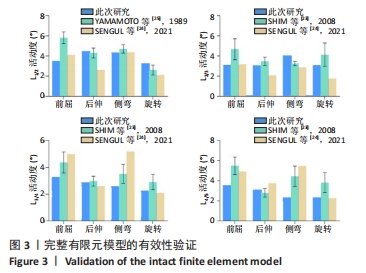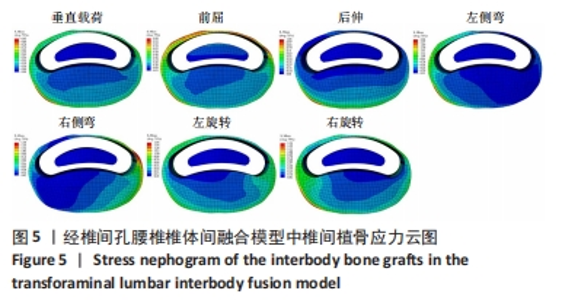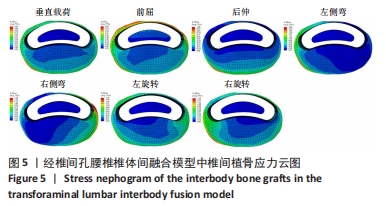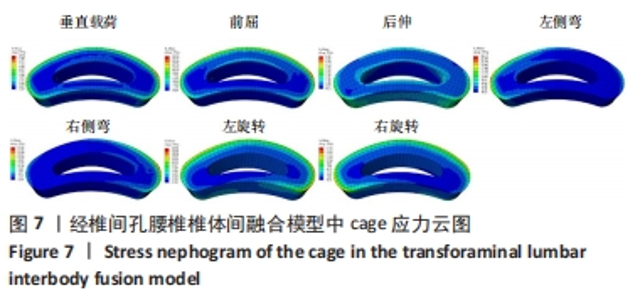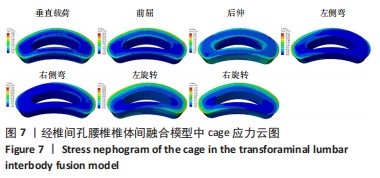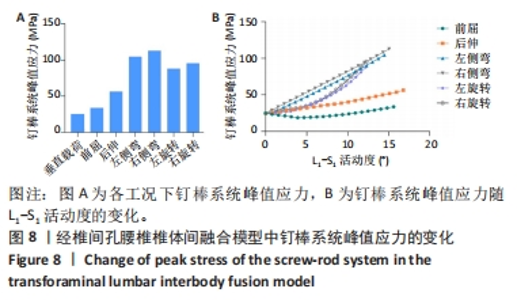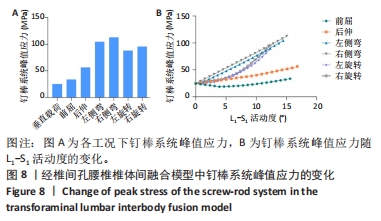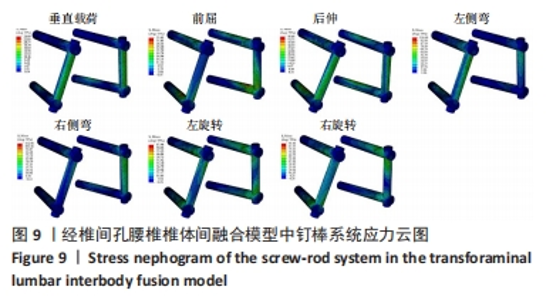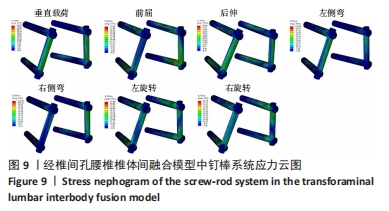Chinese Journal of Tissue Engineering Research ›› 2024, Vol. 28 ›› Issue (36): 5747-5752.doi: 10.12307/2024.662
Previous Articles Next Articles
Finite element analysis of biomechanical effect of lumbar range of motion on the implants after lumbar fusion
Li Ke1, Cao Shuai2, Zhang Qiongchi1, He Xijing1, Li Haopeng1, Li Jie1
- 1Second Department of Orthopedics, Second Affiliated Hospital of Xi’an Jiaotong University, Xi’an 710004, Shaanxi Province, China; 2Department of Orthopedics, Civil Aviation General Hospital, Beijing 100123, China
-
Received:2023-07-21Accepted:2023-10-12Online:2024-12-28Published:2024-02-27 -
Contact:Li Jie, Master, Second Department of Orthopedics, Second Affiliated Hospital of Xi’an Jiaotong University, Xi’an 710004, Shaanxi Province, China -
About author:Li Ke, Second Department of Orthopedics, Second Affiliated Hospital of Xi’an Jiaotong University, Xi’an 710004, Shaanxi Province, China -
Supported by:National Natural Science Foundation of China, No. 82172396 (to LHP)
CLC Number:
Cite this article
Li Ke, Cao Shuai, Zhang Qiongchi, He Xijing, Li Haopeng, Li Jie. Finite element analysis of biomechanical effect of lumbar range of motion on the implants after lumbar fusion[J]. Chinese Journal of Tissue Engineering Research, 2024, 28(36): 5747-5752.
share this article
Add to citation manager EndNote|Reference Manager|ProCite|BibTeX|RefWorks
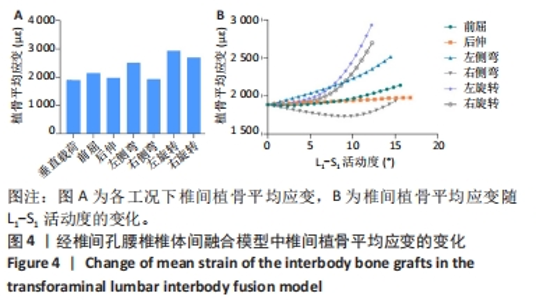
2.2 椎间植骨平均应变 在垂直压缩载荷、前屈、后伸、左侧弯、右侧弯、左旋转及右旋转工况下,椎间植骨的平均应变分别为1 887.47,2 140.01,1 977.96,2 515.23,1 936.49,2 932.00及2 696.60 με(图4A)。与单纯施加垂直压缩载荷相比,施加弯矩后椎间植骨平均应变增加了2.6%-55.3%。在左右旋转工况下,椎间植骨平均应变随着L1-S1活动度的增加呈先慢后快的增加趋势(图4B)。在后伸及左侧弯工况下,椎间植骨平均应变均随着L1-S1活动度的增加而缓慢增加。在前屈工况下,植骨平均应变随着活动度的增加先轻微下降至1 873.70 με,随后逐渐增加。在右侧弯工况下,椎间植骨平均应变随着活动度的增加逐渐下降,活动度达到9.02°时降至最低1 732.03 με,随后逐渐增加。"
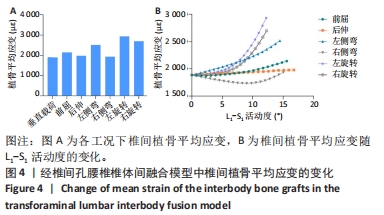

2.3 cage峰值应力 在垂直压缩载荷、前屈、后伸、左侧弯、右侧弯、左旋转及右旋转工况下,cage峰值应力分别为10.24,18.29,5.47,26.11,27.32,16.96及17.73 MPa(图6A)。除了后伸工况,与单纯施加垂直压缩载荷相比,施加弯矩后cage峰值应力增加了65.6%-166.8%,其中侧弯工况下增加更明显。在前屈、左右侧弯及右旋转工况下,cage峰值应力均随着L1-S1活动度的增加基本呈线性增加(图6B)。在后伸工况下,cage峰值应力随着L1-S1活动度的增加基本呈线性减小。在左旋转工况下,cage峰值应力随着活动度的增加先轻微下降至9.31 MPa,随后逐渐增加。"
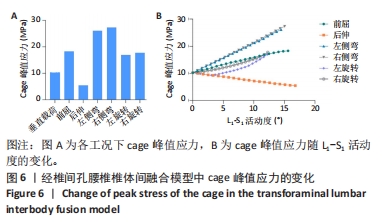
| [1] MACKI M, HAMILTON T, HADDAD YW, et al. Expandable Cage Technology-Transforaminal, Anterior, and Lateral Lumbar Interbody Fusion. Oper Neurosurg (Hagerstown). 2021;21(Suppl 1):S69-S80. [2] MUTHIAH N, YOLCU YU, ALAN N, et al. Evolution of polyetheretherketone (PEEK) and titanium interbody devices for spinal procedures: a comprehensive review of the literature. Eur Spine J. 2022;31(10):2547-2556. [3] LITAK J, SZYMONIUK M, CZYŻEWSKI W, et al. Metallic Implants Used in Lumbar Interbody Fusion. Materials (Basel). 2022;15(10):3650. [4] NUNLEY PD, EASTLACK RK, MILLER LE, et al. Metal-Free Cortico-Pedicular Device for Supplemental Fixation in Lumbar Interbody Fusion. World Neurosurg. 2023;174:4-10. [5] DINIZO M, SRISANGUAN K, DOLGALEV I, et al. Pseudarthrosis and Rod Fracture Rates After Transforaminal Lumbar Interbody Fusion at the Caudal Levels of Long Constructs for Adult Spinal Deformity Surgery. World Neurosurg. 2021;155:e605-e611. [6] JAEGER A, GIBER D, BASTARD C, et al. Risk factors of instrumentation failure and pseudarthrosis after stand-alone L5-S1 anterior lumbar interbody fusion: a retrospective cohort study. J Neurosurg Spine. 2019;31(3):338-346. [7] WONG CE, HU HT, KAO LH, et al. Biomechanical feasibility of semi-rigid stabilization and semi-rigid lumbar interbody fusion: a finite element study. BMC Musculoskelet Disord. 2022;23(1):10. [8] LESZCZYNSKI A, MEYER F, CHARLES YP, et al. Development of a flexible instrumented lumbar spine finite element model and comparison with in-vitro experiments. Comput Methods Biomech Biomed Engin. 2022;25(2):221-237. [9] LAUBACH M, KOBBE P, HUTMACHER DW. Biodegradable interbody cages for lumbar spine fusion: Current concepts and future directions. Biomaterials. 2022;288:121699. [10] VON ARX M, LIECHTI M, CONNOLLY L, et al. From Stoop to Squat: A Comprehensive Analysis of Lumbar Loading Among Different Lifting Styles. Front Bioeng Biotechnol. 2021;9:769117. [11] PARK WM, KIM YJ, WANG SB, et al. Investigation of lumbar spine biomechanics using global convergence optimization and constant loading path methods. Math Biosci Eng. 2020;17(4):2970-2983. [12] ZHU J, SHEN H, CUI Y, et al. Biomechanical Evaluation of Transforaminal Lumbar Interbody Fusion with Coflex-F and Pedicle Screw Fixation: Finite Element Analysis of Static and Vibration Conditions. Orthop Surg. 2022;14(9):2339-2349. [13] SUN Z, SUN Y, LU T, et al. A swelling-based biphasic analysis on the quasi-static biomechanical behaviors of healthy and degenerative intervertebral discs. Comput Methods Programs Biomed. 2023;235: 107513. [14] WICZENBACH T, PACHOCKI L, DASZKIEWICZ K, et al. Development and validation of lumbar spine finite element model. Peer J. 2023;11: e15805. [15] LU T, LU Y. Interlaminar stabilization offers greater biomechanical advantage compared to interspinous stabilization after lumbar decompression: a finite element analysis. J Orthop Surg Res. 2020; 15(1):291. [16] LU T, LU Y. Comparison of Biomechanical Performance Among Posterolateral Fusion and Transforaminal, Extreme, and Oblique Lumbar Interbody Fusion: A Finite Element Analysis. World Neurosurg. 2019;129:e890-e899. [17] WANG B, HUA W, KE W, et al. Biomechanical Evaluation of Transforaminal Lumbar Interbody Fusion and Oblique Lumbar Interbody Fusion on the Adjacent Segment: A Finite Element Analysis. World Neurosurg. 2019;126:e819-e824. [18] LU T, REN J, SUN Z, et al. Relationship between the elastic modulus of the cage material and the biomechanical properties of transforaminal lumbar interbody fusion: A logarithmic regression analysis based on parametric finite element simulations. Comput Methods Programs Biomed. 2022;214:106570. [19] FAN W, GUO LX. A comparison of the influence of three different lumbar interbody fusion approaches on stress in the pedicle screw fixation system: Finite element static and vibration analyses. Int J Numer Method Biomed Eng. 2019;35(3):e3162. [20] PERNA F, BORGHI R, PILLA F, et al. Pedicle screw insertion techniques: an update and review of the literature. Musculoskelet Surg. 2016; 100(3):165-169. [21] KIAPOUR A, MASSAAD E, JOUKAR A, et al. Biomechanical analysis of stand-alone lumbar interbody cages versus 360° constructs: an in vitro and finite element investigation. J Neurosurg Spine. 2022;36(6):928-936. [22] LIANG W, HAN B, HAI Y, et al. Biomechanical Analysis of the Reasonable Cervical Range of Motion to Prevent Non-Fusion Segmental Degeneration After Single-Level ACDF. Front Bioeng Biotechnol. 2022; 10:918032. [23] SHIM CS, PARK SW, LEE SH, et al. Biomechanical evaluation of an interspinous stabilizing device, Locker. Spine (Phila Pa 1976). 2008; 33(22):E820-E827. [24] SENGUL E, OZMEN R, YAMAN ME, et al. Influence of posterior pedicle screw fixation at L4-L5 level on biomechanics of the lumbar spine with and without fusion: a finite element method. Biomed Eng Online. 2021;20(1):98. [25] YAMAMOTO I, PANJABI MM, CRISCO T, et al. Three-dimensional movements of the whole lumbar spine and lumbosacral joint. Spine (Phila Pa 1976). 1989;14(11):1256-1260. [26] DERMAN PB, SINGH K. Surgical Strategies for the Treatment of Lumbar Pseudarthrosis in Degenerative Spine Surgery: A Literature Review and Case Study. HSS J. 2020;16(2):183-187. [27] CHUN DS, BAKER KC, HSU WK. Lumbar pseudarthrosis: a review of current diagnosis and treatment. Neurosurg Focus. 2015;39(4):E10. [28] TURNER CH. Homeostatic control of bone structure: an application of feedback theory. Bone. 1991;12(3):203-217. [29] 张舒,吴兴裕,李莹辉.骨骼的功能适应性与应力应变反应[J].航天医学与医学工程,2001(5):368-372. [30] DONG E, SHI L, KANG J, et al. Biomechanical characterization of vertebral body replacement in situ: Effects of different fixation strategies. Comput Methods Programs Biomed. 2020;197:105741. [31] ZUCKERMAN SL, DEVIN CJ. Pseudarthrosis of the Cervical Spine. Clin Spine Surg. 2022;35(3):97-106. [32] LEBHAR J, KRIEGEL P, CHATELLIER P, et al. Tantalum implants for posterior lumbar interbody fusion: A safe method at medium-term follow-up? Orthop Traumatol Surg Res. 2020;106(2):269-274. [33] KAPOEN C, LIU Y, BLOEMERS FW, et al. Pedicle screw fixation of thoracolumbar fractures: conventional short segment versus short segment with intermediate screws at the fracture level-a systematic review and meta-analysis. Eur Spine J. 2020;29(10):2491-2504. [34] AHN YH, CHEN WM, LEE KY, et al. Comparison of the load-sharing characteristics between pedicle-based dynamic and rigid rod devices. Biomed Mater. 2008;3(4):044101. [35] MAVROGENIS AF, VOTTIS C, TRIANTAFYLLOPOULOS G, et al. PEEK rod systems for the spine. Eur J Orthop Surg Traumatol. 2014;24 Suppl 1: S111-S116. |
| [1] | Shang Peng, Cui Lunxu, Ma Benyuan, Hou Guanghui, Song Wanzhen, Liu Yancheng. Effect of restored height on neighboring vertebrae after vertebral body strengthening: a finite element analysis [J]. Chinese Journal of Tissue Engineering Research, 2025, 28(36): 5741-5746. |
| [2] | Li Zhifei, Yang Yin, Chen Hualong, Liang Qinqiu, Zhong Yuanming, Zhang Yisheng. Finite element analysis of the correlation between tilt angle of titanium cage and postoperative subsidence of titanium cage after anterior subtotal cervical corpectomy, decompression and fusion [J]. Chinese Journal of Tissue Engineering Research, 2024, 28(9): 1313-1319. |
| [3] | Chen Mengmeng, Bao Li, Chen Hao, Jia Pu, Feng Fei, Shi Guan, Tang Hai. Biomechanical characteristics of a novel interspinous distraction fusion device BacFuse for the repair of lumbar degenerative disease [J]. Chinese Journal of Tissue Engineering Research, 2024, 28(9): 1325-1329. |
| [4] | Liang Cheng, Zhang Linqi, Wang Guan, Li Wen, Duan Ke, Li Zhong, Lu Xiaobo, Zhuo Naiqiang. Finite element and biomechanical analysis of different implants in repair for unilateral unstable pelvic posterior ring injury [J]. Chinese Journal of Tissue Engineering Research, 2024, 28(9): 1336-1341. |
| [5] | Yang Junliang, Lu Tan, Xu Biao, Jiang Yaqiong, Wang Fucheng. Three-dimensional finite element analysis of effects of partial anterior cruciate ligament rupture on knee joint stress [J]. Chinese Journal of Tissue Engineering Research, 2024, 28(9): 1347-1353. |
| [6] | Xi Jintao, Lu Qilin, Wang Yang, Wang Xiaojuan, Lyu Peng, Chen Long, Shi Zhen, Xie Wei, Zhu Yiliang, Li Xugui. Risk factors for cage retropulsion following transforaminal lumbar interbody fusion [J]. Chinese Journal of Tissue Engineering Research, 2024, 28(9): 1394-1398. |
| [7] | Xiaheida·Yilaerjiang, Nijiati·Tuerxun, Reyila·Kuerban, Baibujiafu·Yelisi, Chen Xin. Three-dimensional finite element analysis of the distribution pattern of stress in bone tissues with different characteristics [J]. Chinese Journal of Tissue Engineering Research, 2024, 28(8): 1277-1282. |
| [8] | Wang Qiang, Li Shiyun, Xiong Ying, Li Tiantian. Biomechanical changes of the cervical spine in internal fixation with different anterior cervical interbody fusion systems [J]. Chinese Journal of Tissue Engineering Research, 2024, 28(6): 821-826. |
| [9] | Wei Yuanbiao, Lin Zhan, Chen Yanmei, Yang Tenghui, Zhao Xiao, Chen Yangsheng, Zhou Yanhui, Yang Minchao, Huang Feiqi. Finite element analysis of effects of sagittal cervical manipulation on intervertebral disc and facet joints [J]. Chinese Journal of Tissue Engineering Research, 2024, 28(6): 827-832. |
| [10] | Zhang Rui, Wang Kun, Shen Zicong, Mao Lu, Wu Xiaotao. Effects of endoscopic foraminoplasty and laminoplasty on biomechanical properties of intervertebral disc and isthmus [J]. Chinese Journal of Tissue Engineering Research, 2024, 28(6): 833-839. |
| [11] | Kang Zhijie, Cao Zhenhua, Xu Yangyang, Zhang Yunfeng, Jin Feng, Su Baoke, Wang Lidong, Tong Ling, Liu Qinghua, Fang Yuan, Sha Lirong, Liang Liang, Li Mengmeng, Du Yifei, Lin Lin, Wang Haiyan, Li Xiaohe, Li Zhijun. Finite element model establishment and stress analysis of lumbar-sacral intervertebral disc in ankylosing spondylitis [J]. Chinese Journal of Tissue Engineering Research, 2024, 28(6): 840-846. |
| [12] | Huang Peizhen, Dong Hang, Cai Qunbin, Lin Ziling, Huang Feng. Finite element analysis of anterograde and retrograde intramedullary nail for different areas of femoral shaft fractures [J]. Chinese Journal of Tissue Engineering Research, 2024, 28(6): 868-872. |
| [13] | Wang Mingming, Zhang Zhong, Sun Jianhua, Zhao Gang, Song Hua, Yan Huadong, Lyu Bin. Finite element analysis of three different minimally invasive fixation methods for distal tibial fractures with soft tissue injury [J]. Chinese Journal of Tissue Engineering Research, 2024, 28(6): 879-885. |
| [14] | Ning Tianliang, Wang Kun, Wang Lingbiao, Han Pengfei. Finite element analysis on correction effect of varus foot orthosis based on the three-point force principle [J]. Chinese Journal of Tissue Engineering Research, 2024, 28(6): 891-899. |
| [15] | Ji Guizhu, Zheng Qiu, Wang Wuxiang, Wang Guan, Li Wen, Lu Xiaobo, Duan Ke, Li Zhong, Yang Hongbin, Liang Cheng. Finite element simulation and experimental test of normal coracoclavicular ligament and flexible reconstruction [J]. Chinese Journal of Tissue Engineering Research, 2024, 28(5): 706-711. |
| Viewed | ||||||
|
Full text |
|
|||||
|
Abstract |
|
|||||
